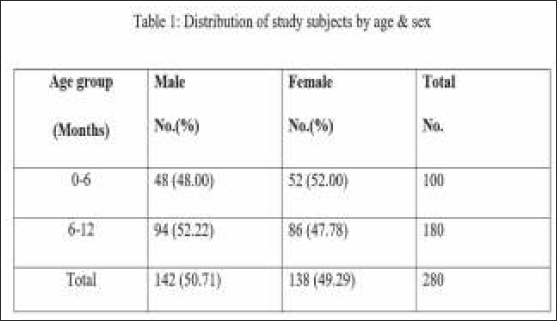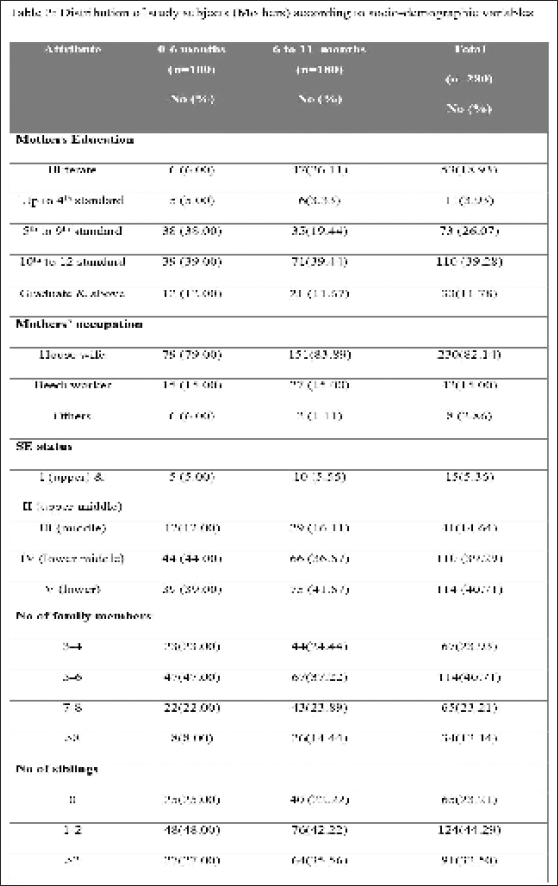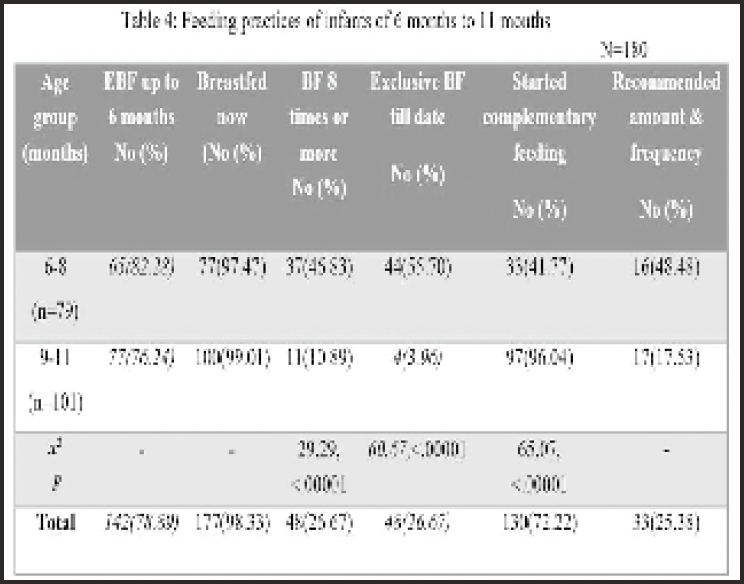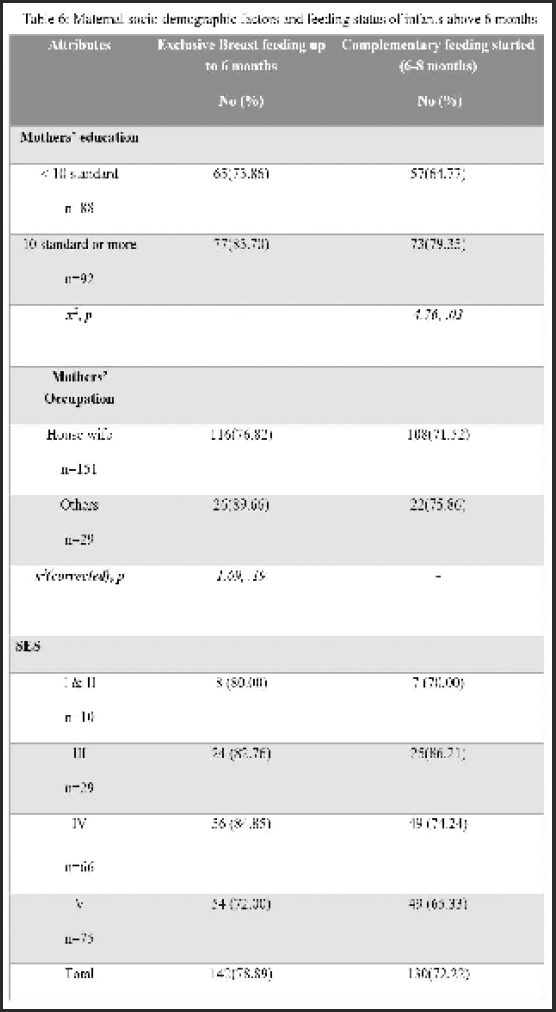Translate this page into:
Infant Feeding Practices in a Rural Muslim Community in Malda District of West Bengal
Corresponding author: Dr Nirmal Kumar Mandal, Department of Community Medicine, Malda Medical College, Malda Email: mandalnirmalkumar@gmail.com, M-9433390288
How to cite this article: Yeasmin N, Mandal N K. Infant Feeding Practices in a Rural Muslim Community in Malda District of West Bengal. J Comprehensive Health 2020;8(2):22-27.
Abstract
Introduction:
Exclusive breast-feeding for first six months of life and semi-solid food after six months in addition to breast feeding is recommended as optimal feeding for infant and young children. There is dearth of data about infant feeding practices among mothers of Muslim Community.
Objectives:
To study infant feeding practices of Muslim mothers and identify feeding problems.
Methods:
A descriptive observational cross-sectional study was conducted on 280 infants in the rural area of Chanchal 2 block of Malda district of West Bengal.
Results:
Ninety one per cent mothers of infants below 6 months were currently breast feeding their babies, whereas only 76% were giving exclusive breast feeding. About Seventy-nine per cent infants above 6 months were on exclusively breastfed up to 6 months, 98% continuing breast feeding. Only 42% of children between 6-8 months started complementary feeding, which was raised to 96% among children of 9-11 months. Cause of discontinuation of EBF before six months was stated to be inadequate milk and mothers' ill health.
Conclusion:
Appropriate interventions are required to train grass-root level workers, involve family members & counsel mothers on infant & young child feeding.
Keywords
Infant feeding practices
Exclusive breast feeding
Complementary feeding
Muslim community
Introduction :
Mother's milk being the safest, cheapest and easily available makes it an ideal food for infants. Exclusive breast-feeding is recommended as optimal feeding for first six months of life and semi-solid food needs to be incorporated after six months in addition to breast feeding.[1]The nutritional assessment provides precise information to identify groups who are at risk and need assistance.[2] The World Health Organisation and United Nations Children's Fund has advocated for increased commitment to appropriate feeding practices for all infants and young children in order to achieve optimal growth and development of health. According to WHO[3] Breast feeding promotes sensory & cognitive development, protects infants from infection and helps quick recovery from illness. Breast feeding also protects from chronic diseases like type2 diabetes, hypertension and cardiovascular diseases. It helps spacing and reduces breast & ovarian cancers of mothers. Inadequate nutrition during the first two years of life may lead to childhood mortality and morbidity, as well as inadequate brain development. Colostrum present in the mother's milk helps to establish important bacteria in the digestive tract and strengthen the
immunity. Moreover, emotionally, breast feeding also strengthens the bonding between the mother and the baby. [1,3,4,5,6,7,8,9]
As per National Family Health Survey-4, in rural area of Malda district, 64% babies less than 6 months are exclusively breastfed and 38.7% of under fives are underweight.[10] Only 4.3% of 6-23 months babies receive an adequate diet. About 50% of population of Malda district are Muslims, and many blocks are predominantly inhabited by them.[11]
Infant feeding practices among Muslim mothers are grossly underreported. With this background the present study was undertaken with the following objectives-
To assess infant feeding practices in a Muslim Community of Malda district, West Bengal.
To identify feeding problems among the study subjects
To study the relation between socio-demographic factors and feeding practices
Material and Method :
A Community based descriptive observational study with cross-sectional design was undertaken for a period of 8 weeks (from April 30, 2019 to 29 June, 2019) at Jalalpur G.P subcentre of Chanchal 2 block in Malda district among mothers with babies below one year (infant). Jamalpur GP subcentre was selected for its Muslim dominated beneficiaries, cooperative Anganwari workers & ANM and accessibility to the investigator for data collection.
Inclusion criteria :
Mothers & their babies less than 1year (infants) residing in the study setting
Exclusion criteria:
Mothers or infants with severe illness or those staying outside the study area during the period of data collection
Estimation of Sample Size:
According to NFHS 4[10] exclusive breastfeeding practices less than 6 months in Malda district was 64%. Based on that, sample size for less than 6 months was estimated to be 100.
(n=4PQ/L2= (4×64×36)/9.62=100, where prevalence of exclusive breast feeding=64%, 95% confidence level & 15% relative error)
As data on timely complementary feeding were lacking in this district, assuming 50% of above 6 months children practicing complementary feeding, estimated sample size becames178. It was rounded to 180.
(n=4PQ/L2= (4×50×50)/7.52=178, where prevalence of complementary feeding=50%, 95% confidence level & 15% relative error)
Sampling Technique: Under Jalalpur G.P subcentre, there were 11 Anganwari centres (AWC). Five AWCs were randomly selected from the list of 11 Angawari centres.
One-fifth of sample (20 infants less than 6 months and 36 infants above 6 months) was selected by systematic random sampling technique from the list of infants of less than 6 months and above 6 months available with Anganwari Workers from each selected centre. If adequate number of study subjects was not available in selected AWC, adjacent AWC was added to make the sampling frame to get the desired number.
Study tools:
Semi-structured pre-designed schedule consisting of questions regarding Socio-demographic characteristics and infant feeding practices
Register of I.C.D.S worker to document age, gender and residence of study subjects.
Mother & child protection card to confirm date of birth
Technique:
Method of data collection:
-
Interview of mothers with pre-tested & predesigned schedule: With the help of Anganwari Workers, selected mothers were interviewed at the ICDS centre by the investigator with pre-tested & pre-designed schedule. The schedule was consisting of questions about sociodemographic characteristics and feeding practices which included breast feeding initiation, colostrum feeding, duration of exclusive breast feeding, continuation of breastfeeding, initiation of complementary food, current feeding practices like type of the food, its amount and frequency, etc.
Informed consent from the mother was taken before interview. Apart from other relevant information, mothers were also asked about current feeding practices of the baby in last 24 hours (point-in-time method)[12] to avoid recall bias.
Breast-feeding assessment: Investigator (first author) was given hands-on-training on breast feeding assessment in the immunization clinic of the Department of Community Medicine, Malda Medical College by one faculty member. In the selected Anganwari centres, breastfeeding process was observed by the investigator herself while mothers were giving breast feeding to the babies. During assessment, positioning of the baby, its attachment to mother's breast & effective suckling were noted. Privacy was ensured while doing assessment of breast-feeding. Investigator visited repeatedly to complete assessment of hundred mothers.
Data analysis:
Raw data was entered in MS Excel sheet for analysis. Findings were presented in form of statistical tables and charts. Rates/proportion was calculated. Chi square was used as a test of significance.
Ethical issue:
Necessary permission was taken from the Institutional Ethics Committee
Case definition of different variables:
Exclusive Breast Feeding: Giving the baby only mother's milk, and no other food or drink except for medications
Pre-lacteal feed:
External feeding given before the initiation of mother's breast milk, eg: Honey, Janamghutti
Timely complementary feeding:
Introduction of soft semisolid foods after six months in addition to breast milk
Breast feeding assessment:
Proper attachment
Mouth widely open
Chin touching breast
Lower lip turned outward
Upper areola more visible than lower areola
Proper Positioning
Head and body of baby in a straight line
Head and body both turned towards the mother
Baby's body in close contact to the mother
Mother holding baby properly with both hands
Effective suckling: Slow deep sucks with pause
Feeding Problem:
It is the gap between consumed food & recommended food (type, frequency & amount) according to age specific guideline of Mothers' Absolute Affection (MAA) programme[1]
Results:
Hundred infants of less than 6 months, and 180 of 6 months & above were selected for the study. Out of them boys were 142(50.71%) and girls were 138(49.28%) with a ratio of 1:0.97. (Table-1)

Education of more than 50% of mothers (51.06%) was above 10 standards, and 18.93% of them were illiterate. Most of the mothers were house-wives (82.14%) and 15% were bidimakers. About 80% of mothers were belonging to lower or lower middle classes (as per B G Prasad's scale based on CPI- IW of Jan 2019). Average number of family members was 6 with a range between 3 to 12. Twenty-three per cent was single child, whereas 32.5% have more than 2 siblings (Table 2).

Feeding Practices among infants up to 6 months old
Ninety-two per cent of mothers fed colostrum to their babies and 18 mothers (18%) gave pre-lacteal feeding. Mostly powder milk was used as pre-lacteal food.
Only 24% & 28% of mothers were found to maintain proper positioning & attachment respectively while breastfeeding their babies. For young infants less than 2 months 48% was found to be well attached. Thirty-two per cent mothers initiated breast feeding within one hour. Ninety-one per cent mothers of infants below 6 months were currently breast feeding their babies, whereas only 76% were giving exclusive breast feeding. Continuation EBF was found more in young infants less than 4 months (83-84%). Most of mothers (92%) used to feed during night. Breast feeding 8 times or more given to 80% of young infants which were coming down only 27% for age of infants between 4-6 months. Seventy nine per cent male babies are continuing exclusive breast feeding, whereas among girl child it was 73%. About 67 % of male babies were offered breast milk 8 times or more in 24 hours, which were less among female children (54%). (Table 3)

Feeding practices among infants between 6-11 months
About Seventy-nine per cent infants above 6 months were on exclusively breastfed up to 6 months. Ninety-eight per cent were continuing breast feeding and 26.67 % were given breast milk 8 times or more in 24 hours. Same number of children (48) were still on exclusive breast milk, of them 4 children were above 9 months. Number of children who discontinued EBF before 6 months was 38. Causes of cessation of EBF before six months were, according to the mothers, inadequate milk (26) and Mothers' ill health (12). Only forty-two per cent of children between 6-8 months started complementary feeding, which was raised to 96% among children of 9-11 months. Only 25% of them used to take recommended amount and frequency. Food offered as complementary food were biscuit, cow's milk, rice, mango pulp, powder milk, ready made Infant Feeding Formulae, egg, fruits like banana etc. Among 50 children not yet started complementary feeding, 17 mothers said that baby refused to take soft food, 10 mothers were not aware about time of initiation, and 23 mothers thought breast milk were enough for their children at that time. (Table 4).

Impact of maternal socio-demographic factors on feeding practices:
Seventy-seven per cent and 74% of mothers below 10 & above 10 standards respectively exclusively breastfed their babies. Colostrum feeding was almost equal among mothers below and above 10 standard of education. Sixty-five per cent of mothers above 10 standard education breastfed 8 times or more in 24 hours which were more compared to mothers with education below 10 standards (55%). Similar trend was found in case of attachment during breast feeding.
Colostrum feeding, Exclusive breast feeding, frequency of breast feeding were comparatively better among mother with other occupation (95.24%, 90.48% & 71.43% respectively) compared to housewives (84.81%, 72.15% & 56.96%). Mothers belonging to Middle to upper class practiced exclusively breast feeding, colostrum feeding and more frequent breast feeding proportionately more compared to lower & lower middle SE classes.
Colostrum feeding, exclusive breast feeding and frequency of breast feeding were comparatively better among mothers having more than one child (89.33%, 78.67% & 64.00% respectively) compared to mothers with single child (80.00%, 68.00% & 48.00% respectively).(Table 5).

Initiation of complementary feeding & exclusive breast feeding up to 6 months among infants of 6-11 months old were 79.35% & 83.7% respectively, where mothers' education was above 10 standards. Comparatively less proportion (64.77% & 73.86% respectively) was found among infants of mothers below 10 standard educations. Proportion of initiation of complementary feeding & exclusive breast feeding up to 6 months was comparatively better among mothers with other occupation compared to house-wives. No statistical difference was found between socio-economic status and feeding practices for infant above 6 months. (Table 6)

Discussion :
A descriptive type of observational study was conducted in a Muslim community of a rural setting of Malda District of West Bengal to assess infant feeding practices and identify sociodemographic factors influencing these practices. Out of 280 infants selected for the study, number of infants of age group 0-5 months and 6-11 months was 100 and 180 respectively. Fifty-one per cent of them were male and 49% female. Almost 51% mothers completed 10 standard of education. They were mostly house-wives (82%) & belonged to lower or lower middle classes (80%). Average number of family members was 5.9.
Ninety-two per cent mothers used to feed colostrum to their babies. Only 28% infants under 6 months were found to be well attached to breast while feeding. Ninety three per cent babies were currently breast-fed, but continuation of EBF was rather low (76%). This rate was found better compared to RSOC report in India (64.9%),[13] and status of West Bengal & Malda, 52% & 64% respectively, as per NFHS 4.[10,14] Continuation of EBF was more among young infants (84%) compared to 4-5 months old (60.6%). Similarly, breast feeding 8 times or more in 24 hours was more in young infants (80%) compared to 4-5 months old babies (27%). Breast feeding during night was found in 92% mothers. No gender differences were noticed in breast feeding practices except frequency of breast feeding which was found more in male babies (66.7% vs 53.8%).
Exclusive breast feeding up to 6 months was found in 78.9% of infants of 6-11 months old. In a study conducted earlier in West Bengal was found to be 58.7%.[15] Ninety eight percent of this age group was continuing breast feeding. Complementary foods have been introduced in 72% babies, which was much less (41.8%) in 6-8 months old babies, 55.7% of them was found to depend on EBF only. Four babies above 9 months were still continuing EBF. Status of complementary feeding was found to vary from one survey to other. It was found to be 50.5% & 52% in India[13] & West Bengal respectively.[14] Complementary feeding in recommended amount and frequency were found only in 25% babies above six months, which was only 17.5% for infants above 9 months. Similar findings were revealed in Rapid survey on children where only 36.3% children of 6-8 months fed a minimum number of times, and 19.9 % had minimum dietary diversity.[13] Mothers with education status above 10 standard showed better infant feeding practices with respect to frequency of breast feeding (64.7% vs 55.1%), attachment(37.2% vs 18.4%), initiation of complementary feeding (79.3% vs 64.8%), EBF up to 6 months(83.7% vs 73.8%) compared to their counterparts with education below 10 standard.
Mothers having occupation 'other' category showed better infant feeding practices compared to house-wives with respect to attributes like colostrum feeding, exclusive breast feeding, frequency of breast feeding & EBF up to six months. Mothers having more than 1 child showed better infant feeding practices.
Many authors worked on factors contributing to infant feeding practices of mothers. Maternal education below secondary level contributed to pre-lacteal feeding and failure to practice exclusive breastfeeding.[16] In some settings, multi parity has a positive impact on breastfeeding.[17] Education of mother about complementary feeding led to an extra weight gain in the intervention group compared to control.[18]
Conclusion:
The proposed study was conducted in a rural area, where socioeconomically poor Muslim community live. The feeding problems like inappropriate, inadequate or less frequent feeding, delayed initiation of complementary feeding evident in the study, which might lead to under-nutrition.
This study revealed that breast feeding & breast feeding during night were almost universal. Continuation of exclusive breast feeding gradually came down with advancement of age of the infants. Exclusive breast feeding up to six months was 79% among infants of 6-11 months old. Timely complementary feeding was not initiated in more than 50% infants between 6-8 months; almost same number of this age group was on only breast milk.
At the end of data collection, mothers meeting was conducted with the help of Anganwari Workers and feeding problems found out through assessment were discussed and necessary corrective measures were taken.
Regular training of grass root level workers on IYCF, awareness generation among mothers through mothers' meeting and counseling to identify feeding problems and helping & supporting mothers to solve the identified problems are urgently required.
Acknowledgement:
Authors are thankful to the Indian Council of Medical research (ICMR) for approval & support to the project as SHORT TERM STUDENTSHIP (STS). We express our sincere thanks to the ICDS Workers (AWW) & mothers of infants of selected AWCs of Jalalpur G.P subcentre, Malda
Conflict of Interest:
None declared
Source of Funding:
ICMR STS Project
References:
- Park's textbook of Preventive and Social Medicine. Bhanot Publisher, Jabalpur :646.
- [Google Scholar]
- Long-term effects of breastfeeding: a systematic review. World Health Organization 2013 http://www.who.int/iris/handle/10665/79198 (accessed )
- [Google Scholar]
- Fetal and Early Childhood Under nutrition, Mortality, and Lifelong Health. . 2012;337:1495-9. Science (New York, N.Y.)
- [CrossRef] [PubMed] [Google Scholar]
- Cancer Causes Control. . 2007;18:517. https://doi.org/10.1007/s10552-007-0130-2 (accessed )
- [CrossRef] [PubMed] [Google Scholar]
- Breast-Feeding and Cancer: The Boyd Orr Cohort and a Systematic Review with Meta-Analysis. JNCI: Journal of the National Cancer Institute. 2005;97(19) 5:1446-1457. https://doi.org/10.1093/jnci/dji291 (accessed )
- [CrossRef] [PubMed] [Google Scholar]
- Duration of Lactation and Incidence of Maternal Hypertension: A Longitudinal Cohort Study. American Journal of Epidemiology. 2011;174(10):1147-1158. https://doi.org/10.1093/ aje/kwr227 (accessed )
- [CrossRef] [PubMed] [Google Scholar]
- The risks and benefits of infant feeding practices for women and their children. Journal of Perinatology. 2010;0(3):155-62.
- [CrossRef] [PubMed] [Google Scholar]
- Ministry of Health and Family welfare. District fact Sheet, Malda. National Family Health Survey-4 2015-16
- [Google Scholar]
- Infant and young child feeding perceptions and practices among mothers in a rural area of West Bengal, India. Annals of Medical and Health Sciences Research. 2013;3(3):370-375.
- [CrossRef] [PubMed] [Google Scholar]
- Maternal socio-demographic factors influencing the initiation and exclusivity of breastfeeding in a Nigerian semi-urban setting. Maternal and Child Health Journal. 2010;14(3):459-465.
- [CrossRef] [PubMed] [Google Scholar]
- Determinants of breastfeeding patterns among mothers in Anambra State, Nigeria. South African Journal of Child Health. 2010;5(4):112-116.
- [Google Scholar]
- Impact of maternal education about complementary feeding and provision of complementary foods on child growth in developing countries. BMC Public Health 2011
- [CrossRef] [PubMed] [Google Scholar]






